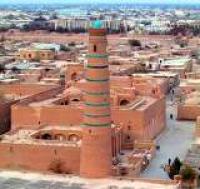You are here
Kurynish Khan madrasah in Khiva.

Khiva sights tour.
"Where did we come from?" Where do we take our way?
What is the meaning of our life? He is incomprehensible to us.
How many clean showers under the wheel azure
Burns to ashes, to dust, and where, say, smoke? "
Omar Khayyam.
Educational tours in Khiva.
Modern Kurnysh Khan was started by the construction of El-Tezar Khan under the leadership of his chief adviser Yusuf-Miktar. It is a separate courtyard surrounded by a common low adobe wall.
It is possible to enter through it through the only rather narrow door in the eastern wall having entered it, you get into the courtyard, in the middle of which there is a round, brick terrace intended for the installation of a yurt. In this yurt, the Khiva khans arranged to receive Turkmen and Karakalpak sardars and biys, deliberately adapted to their tastes and nomadic traditions.
To the left of the entrance, on the south side of the courtyard, stands a beautiful iwan resting on a brick platform, resting on two carved columns. The walls of the quince are entirely lined with irrigated bricks, painted with a greenish-white color on a blue background.
Under the ayvan ceiling there is a ribbon of poems in Uzbek. The ceiling of the aivan was restored in 1934 by the Hivkstararis izan rasNiSan by multicolor plant patterns. In the south wall of the aivan, there are three exits with carved doors that lead into the reception or throne room.
The narrow room of the throne room stretches along the length of the aivan. In the short western wall of his made niche for the seat of the Khan, and the rest of the room was intended for guests. The walls are decorated with panels of carved alabaster, painted with multi-colored paints.
The ceiling is painted by the Hivcomstaris in 1933 during the renovation again without any correspondence with the original patterns of the old paintings. This hall reminds us of the throne room of the Kokand palace of Khudoyar Khan and the living rooms of many houses of the Bukhara, Samarkand and Tashkent rich people of the XIXth century.
On the sides of the niche there are two doors that lead to a small room designed for Khan’s personal rest. Its walls are decorated with simple ganch plaster with simple carved patterns. On the west side of the courtyard is a waiting room. It is close in size to the throne room, but it is of no interest from any side.
Next to it there were 5 small rooms, something like a hudjr, connected by arched passages. They kept the Khan's treasury, chased courtyard, summer and winter mosques in Kunya Ark A small open courtyard of the summer mosque is closed on the south side by a beautiful aivan of the mosque, resting on thin wooden columns painted in the form of a rope.
The walls of the aivan, mihrab and minbar are entirely lined with irrigated tiles with paintings of plant patterns, like the aivan of Kurnysh-Khana, but the tiles are higher in quality and subtlety of the pattern. At the ceiling there is a ribbon of irrigated tiles with calligraphically written Persian verses that say that this mosque was built on the orders of Allah Quli Khan, and the words: the date of its construction corresponding to 1838 is indicated.
The ceiling of the quince is decorated with colorful plant patterns with gilding. The builders were her court masters - the mouth of Ibadullah and the mouth of Abdullau, of whom the latter is known among the Khivans for their manual dexterity under the nickname Jean (devil).
To the west of the summer mosque, there is a winter mosque that looks like a simple rectangular room with a flat ceiling on the unpretentious carved pillars. In the northeastern corner of the courtyard of the summer mosque there are three brick rooms of the chased courtyard, covered with arches of the Balkhi type.
These ceilings collapsed and were successfully restored by the Hywstarstar in 1937. Here was the smelting of metals and coinage. Several melting crucibles from the chased yard are kept in the Khiva Museum.
Enlightener:
Ya. G. Gulyamov. "Monuments of the city of Khiva". Publishing house UzFAN. Tashkent. 1941







